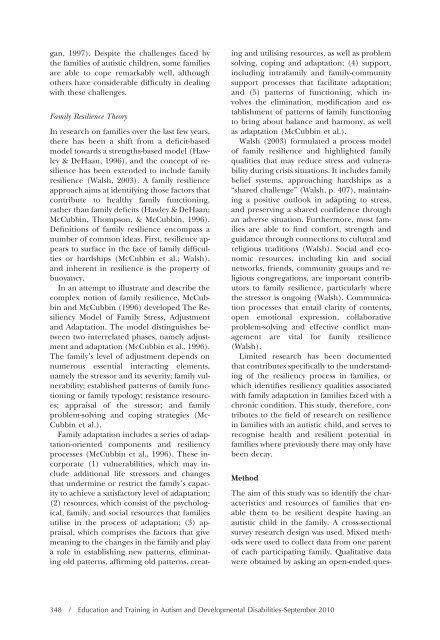Education and Training in Autism and Developmental Disabilities
Education and Training in Autism and Developmental Disabilities
Education and Training in Autism and Developmental Disabilities
Create successful ePaper yourself
Turn your PDF publications into a flip-book with our unique Google optimized e-Paper software.
gan, 1997). Despite the challenges faced by<br />
the families of autistic children, some families<br />
are able to cope remarkably well, although<br />
others have considerable difficulty <strong>in</strong> deal<strong>in</strong>g<br />
with these challenges.<br />
Family Resilience Theory<br />
In research on families over the last few years,<br />
there has been a shift from a deficit-based<br />
model towards a strengths-based model (Hawley<br />
& DeHaan, 1996), <strong>and</strong> the concept of resilience<br />
has been extended to <strong>in</strong>clude family<br />
resilience (Walsh, 2003). A family resilience<br />
approach aims at identify<strong>in</strong>g those factors that<br />
contribute to healthy family function<strong>in</strong>g,<br />
rather than family deficits (Hawley & DeHaan;<br />
McCubb<strong>in</strong>, Thompson, & McCubb<strong>in</strong>, 1996).<br />
Def<strong>in</strong>itions of family resilience encompass a<br />
number of common ideas. First, resilience appears<br />
to surface <strong>in</strong> the face of family difficulties<br />
or hardships (McCubb<strong>in</strong> et al.; Walsh),<br />
<strong>and</strong> <strong>in</strong>herent <strong>in</strong> resilience is the property of<br />
buoyancy.<br />
In an attempt to illustrate <strong>and</strong> describe the<br />
complex notion of family resilience, McCubb<strong>in</strong><br />
<strong>and</strong> McCubb<strong>in</strong> (1996) developed The Resiliency<br />
Model of Family Stress, Adjustment<br />
<strong>and</strong> Adaptation. The model dist<strong>in</strong>guishes between<br />
two <strong>in</strong>terrelated phases, namely adjustment<br />
<strong>and</strong> adaptation (McCubb<strong>in</strong> et al., 1996).<br />
The family’s level of adjustment depends on<br />
numerous essential <strong>in</strong>teract<strong>in</strong>g elements,<br />
namely the stressor <strong>and</strong> its severity; family vulnerability;<br />
established patterns of family function<strong>in</strong>g<br />
or family typology; resistance resources;<br />
appraisal of the stressor; <strong>and</strong> family<br />
problem-solv<strong>in</strong>g <strong>and</strong> cop<strong>in</strong>g strategies (Mc-<br />
Cubb<strong>in</strong> et al.).<br />
Family adaptation <strong>in</strong>cludes a series of adaptation-oriented<br />
components <strong>and</strong> resiliency<br />
processes (McCubb<strong>in</strong> et al., 1996). These <strong>in</strong>corporate<br />
(1) vulnerabilities, which may <strong>in</strong>clude<br />
additional life stressors <strong>and</strong> changes<br />
that underm<strong>in</strong>e or restrict the family’s capacity<br />
to achieve a satisfactory level of adaptation;<br />
(2) resources, which consist of the psychological,<br />
family, <strong>and</strong> social resources that families<br />
utilise <strong>in</strong> the process of adaptation; (3) appraisal,<br />
which comprises the factors that give<br />
mean<strong>in</strong>g to the changes <strong>in</strong> the family <strong>and</strong> play<br />
a role <strong>in</strong> establish<strong>in</strong>g new patterns, elim<strong>in</strong>at<strong>in</strong>g<br />
old patterns, affirm<strong>in</strong>g old patterns, creat-<br />
<strong>in</strong>g <strong>and</strong> utilis<strong>in</strong>g resources, as well as problem<br />
solv<strong>in</strong>g, cop<strong>in</strong>g <strong>and</strong> adaptation; (4) support,<br />
<strong>in</strong>clud<strong>in</strong>g <strong>in</strong>trafamily <strong>and</strong> family-community<br />
support processes that facilitate adaptation;<br />
<strong>and</strong> (5) patterns of function<strong>in</strong>g, which <strong>in</strong>volves<br />
the elim<strong>in</strong>ation, modification <strong>and</strong> establishment<br />
of patterns of family function<strong>in</strong>g<br />
to br<strong>in</strong>g about balance <strong>and</strong> harmony, as well<br />
as adaptation (McCubb<strong>in</strong> et al.).<br />
Walsh (2003) formulated a process model<br />
of family resilience <strong>and</strong> highlighted family<br />
qualities that may reduce stress <strong>and</strong> vulnerability<br />
dur<strong>in</strong>g crisis situations. It <strong>in</strong>cludes family<br />
belief systems, approach<strong>in</strong>g hardships as a<br />
“shared challenge” (Walsh, p. 407), ma<strong>in</strong>ta<strong>in</strong><strong>in</strong>g<br />
a positive outlook <strong>in</strong> adapt<strong>in</strong>g to stress,<br />
<strong>and</strong> preserv<strong>in</strong>g a shared confidence through<br />
an adverse situation. Furthermore, most families<br />
are able to f<strong>in</strong>d comfort, strength <strong>and</strong><br />
guidance through connections to cultural <strong>and</strong><br />
religious traditions (Walsh). Social <strong>and</strong> economic<br />
resources, <strong>in</strong>clud<strong>in</strong>g k<strong>in</strong> <strong>and</strong> social<br />
networks, friends, community groups <strong>and</strong> religious<br />
congregations, are important contributors<br />
to family resilience, particularly where<br />
the stressor is ongo<strong>in</strong>g (Walsh). Communication<br />
processes that entail clarity of contents,<br />
open emotional expression, collaborative<br />
problem-solv<strong>in</strong>g <strong>and</strong> effective conflict management<br />
are vital for family resilience<br />
(Walsh).<br />
Limited research has been documented<br />
that contributes specifically to the underst<strong>and</strong><strong>in</strong>g<br />
of the resiliency process <strong>in</strong> families, or<br />
which identifies resiliency qualities associated<br />
with family adaptation <strong>in</strong> families faced with a<br />
chronic condition. This study, therefore, contributes<br />
to the field of research on resilience<br />
<strong>in</strong> families with an autistic child, <strong>and</strong> serves to<br />
recognise health <strong>and</strong> resilient potential <strong>in</strong><br />
families where previously there may only have<br />
been decay.<br />
Method<br />
The aim of this study was to identify the characteristics<br />
<strong>and</strong> resources of families that enable<br />
them to be resilient despite hav<strong>in</strong>g an<br />
autistic child <strong>in</strong> the family. A cross-sectional<br />
survey research design was used. Mixed methods<br />
were used to collect data from one parent<br />
of each participat<strong>in</strong>g family. Qualitative data<br />
were obta<strong>in</strong>ed by ask<strong>in</strong>g an open-ended ques-<br />
348 / <strong>Education</strong> <strong>and</strong> <strong>Tra<strong>in</strong><strong>in</strong>g</strong> <strong>in</strong> <strong>Autism</strong> <strong>and</strong> <strong>Developmental</strong> <strong>Disabilities</strong>-September 2010

















